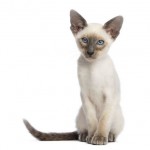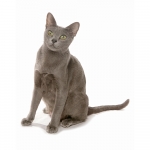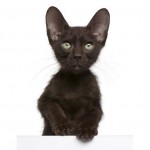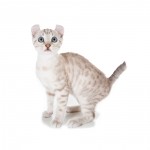

Kittens For Sale
Featured Listings (Follow Breed)
Singapura Cat Breed Description
Singapura Traits At A Glance
Active
Playful
Requires Attention
Affectionate
Vocal
Docile
Intelligent
Independent
Health
Grooming
Child Friendly
Pet Friendly
Size: The Singapura cat breed is small in size, typically weighing from 4 to 8 pounds.
Characteristics: The Singapura is a sweet, small cat that, while smaller than most cats, is still muscular. They have rounded heads with large ears that are slightly pointed. Their eyes are strikingly beautiful and one of their most well known features. Singapura eyes are large, almond-shaped and are a brilliant color of hazel, green or yellow. They have a small body but are stocky and muscular and their legs are muscular as well.
Temperament: The Singapura cat is an incredibly affectionate cat that has often been called a "pest" because they want to be with their companions, at all times. They are not shy in the slightest, they easily make new friends and will want to be involved in all of the activities that the family is doing. They are incredibly intelligent and love to play and learn new games. They will entertain you and keep you on your toes with their creative antics. But, just because they are so active, does not mean they aren't affectionate and loving. They are fiercely loyal and bond intensely with their family.
Care: The Singapura has a short coat that is relatively easy to care for. Brush or comb their hair weekly to keep their coat looking it's best and most shiny. Bathe only as needed and simply trim their nails and clean their ears. Lastly, be sure to brush their teeth frequently to prevent periodontal disease and keep their breath smelling minty-fresh!
Coat: The coat of the Singapura is short, fine and has a beautiful sable-brown color. The color is a sepia colored Agouti coat.
Origin: Singapura is Malaysians for Singapore and that is where the cat originates from. They are said to be descendents of street cats that have lived on the island since about 1965. Not much was thought of them and they were often called "sewer cats." The exact history of the Singapura cat, much like many other breeds, is a bit blurry. There are different accounts of exactly how the breed came to be or made its way to America. The small island cat made its way to the United States in 1975 when Tommy and Hal Meadow brought back 3 cats named Tess, Tickle and Pusse.
These three cats had ticked, sepia-colored coats. Tommy Meadows had some cat fancy knowledge as he had previously been a CFA Judge and cat breeder. Tommy and Hal proceeded to create a breeding program with their adorable cats to develop the breed. They consulted with a British geneticist and bred to achieve certain desirable traits and characteristics. Soon, Tommy wrote a breed standard and the Singapura breed became an established bred in the United States. In 1980, Barbara Gilbertson, a fellow breeder, imported another Singapura cat named Chiko that went on to join the Singapura breeding program. Meadow then created the United Singapura Society in order to "protect, preserve and promote" the breed. In 1979, the ICA and CFF were the first cat registries to accept the Singapura cat breed for championship status.
Then, in 1982 the CFA accepted the Singapura breed for registration and later, in 1988, granted championship status. Controversy and discord arose among Singapura cat breeders when concern arose over the small size of Singapura cats. There was concern that excessive inbreeding was creating the small size of cats but that concern was not echoed in Tommy Meadows. Meadows opposed importing more cats from Singapore to widen the gene pool for the breeding program and this caused a rift among the breeders. The other breeders decided to form separate breed clubs. Breeders began to import additional Singapura cats from Singapore and Jerry Mayes went on a trip to gather a significant amount of cats to bring back to America.
Mayes discovered that the Meadows' cats from Singapore may have originally been from America. Tommy Meadows admitted that his cats were not originally from Singapore but the controversy did not end there. Later, other breeders became concerned that the breed was not a unique breed but actually the result of mating Abyssinian and Burmese cats. Ultimately though, because there is no way to prove without a shadow of a doubt the origins of the Singapura, today it is accepted and loved as the unique and lovely breed that it is.






























